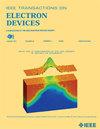A Novel Ultraviolet Photodetector With High Responsivity and Low Operating Voltage Based on Hybrid Si/SiC Technology
IF 2.9
2区 工程技术
Q2 ENGINEERING, ELECTRICAL & ELECTRONIC
引用次数: 0
Abstract
In this letter, we demonstrate a novel ultraviolet (UV) photodetector with extremely high responsivity under low operating voltage of 1 V. A Silicon/silicon carbide (Si/SiC) hybrid substrate and fabrication process are developed to monolithically integrate a SiC photodetector with a Si MOSFET. The SiC photodetector provides excellent UV selectivity, and its output signal is further amplified through the integrated silicon MOSFET. The UV photodetector exhibits a responsivity up to基于硅/碳化硅混合技术的新型高响应性低工作电压紫外探测器
在这封信中,我们展示了一种新型紫外(UV)光电探测器,在1 V的低工作电压下具有极高的响应率。开发了一种硅/碳化硅(Si/SiC)混合衬底和制造工艺,将SiC光电探测器与硅MOSFET单片集成。SiC光电探测器具有优异的紫外选择性,其输出信号通过集成的硅MOSFET进一步放大。在1 v漏极电压下,该紫外光电探测器在260 nm波长下的响应率高达$4.63\ × 10^{{7}}$ a /W,与SiC金属-半导体-金属(MSM)光电探测器相比提高了$3.08\ × 10^{{7}}$ $。此外,在4~\mu $ W/cm2的光强下,探测器表现出良好的响应速度,上升和下降时间分别为29和17~\mu $ s。此外,通过调整栅极电压对探测率进行了优化,实现了4.18\ × 10^{{16}}$ Jones的创纪录高值。
本文章由计算机程序翻译,如有差异,请以英文原文为准。
求助全文
约1分钟内获得全文
求助全文
来源期刊

IEEE Transactions on Electron Devices
工程技术-工程:电子与电气
CiteScore
5.80
自引率
16.10%
发文量
937
审稿时长
3.8 months
期刊介绍:
IEEE Transactions on Electron Devices publishes original and significant contributions relating to the theory, modeling, design, performance and reliability of electron and ion integrated circuit devices and interconnects, involving insulators, metals, organic materials, micro-plasmas, semiconductors, quantum-effect structures, vacuum devices, and emerging materials with applications in bioelectronics, biomedical electronics, computation, communications, displays, microelectromechanics, imaging, micro-actuators, nanoelectronics, optoelectronics, photovoltaics, power ICs and micro-sensors. Tutorial and review papers on these subjects are also published and occasional special issues appear to present a collection of papers which treat particular areas in more depth and breadth.
 求助内容:
求助内容: 应助结果提醒方式:
应助结果提醒方式:


